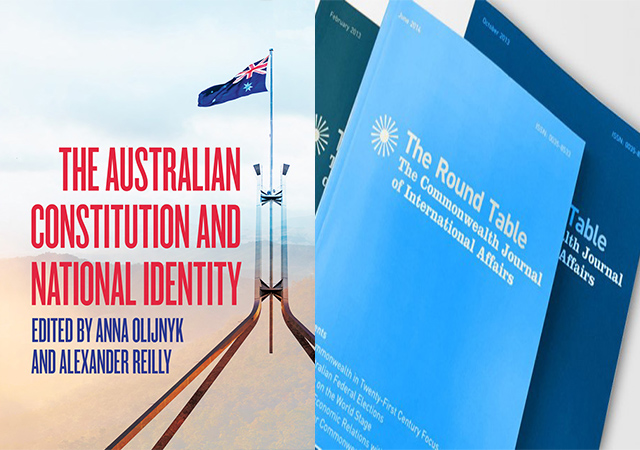
[This is an excerpt from an article in THe Round Table: The Commonwealth Journal of International Affairs. Opinions expressed do not reflect the position of the editorial board.]
All the chapters are well written and informative. Each one warrants a considered response, but here I will focus on what seem to be the most important concerns raised by the book concerning Australian national identity as reflected in the Constitution. In my view the biggest issues are the position of the indigenous people and the status of Australia as a constitutional monarchy or republic. Some chapters are more engaged with these topics than are others, but the more specialised chapters provide insights into some aspects of these broader issues as well as improving understanding of their own particular themes. A third big issue well discussed in this book concerns the issue of Australian citizenship, and particularly the unsatisfactory nature of section 44 given Australia’s cultural diversity. However I am unaware of any significant moves to change section 44 through a referendum, and any such moves could well be contentious.
On the indigenous and republican issues there have been major attempts to effect constitutional change, with referenda in 2023 and 1999 respectively. The failure of the attempt to include an advisory indigenous Voice (to parliament and government) in the referendum of 14 October 2023 (only 39.94% of voters in favour and no state) has had a chastening effect. Success would have emboldened advocates of another referendum on becoming a republic, but this issue has now slipped down the agenda.
If I have any major criticism of the arguments put in this book, it is that the authors are often overly sanguine about the prospects for bringing about change. It is well to argue as to what the ideal would be in terms of the Australian Constitution reflecting Australian national identity, but one needs to consider the political obstacles. The reference to a politically conservative culture (p. 275) is apt. The arguments for change in relation to the big issues are well put in this book, but on all these issues there are alternative arguments. With the Voice referendum, ignoring the ‘if you don’t know, vote No’ appeal, there were arguments about ‘equality before the law’ and the merits of assimilationism. On the issue of ‘monarchy versus republic’ the polls mostly indicate a fluctuating position and certainly a divided community (and often low salience). If Section 44 were ever put to a referendum, it could no doubt excite anti-immigrant prejudice and indicate the appeal of a narrow nationalism.
Book review: Australia and the world 1920-1930: Documents on Australian foreign policy
Australia’s 2017 Foreign Policy White Paper: Deconstruction and Critique
I would argue that one should not put too much store on the Australian Constitution as a vehicle for realising a fuller Australian national identity. Interpretation by the courts might allow more scope for dealing with some of the issues raised in this book. On the indigenous issue there are other possibilities such as a legislated Voice at national level, as well as regional and local voices. The referendum result has been a setback for progress on the matter at state as well as at federal level, but Victoria already has a legislated voice (the First People’s Assembly) that in turn is overseeing the processes of truth-telling and treaty-making in that state. Moves towards ‘treaty’ or ‘treaties’ at national level in line with the Uluru Statement from the Heart of 2017 are likely to be slower because of the referendum result.
On the issue of an Australian republic much of the symbolism of monarchy has already disappeared but the monarchical basis of the Australian Constitution remains, with the very first sentence of the preamble referring to the establishment of ‘one indissoluble Federal Commonwealth under the Crown of the United Kingdom of Great Britain and (Northern) Ireland’ (the reference to the ‘Queen of England’ (pp. 105-106), recalling Elizabeth I, the last monarch bearing this title if one can oversimplify, is ahistorical). Recalling Ireland’s experience from 1922 to 1949 (with the position of governor-general under the Irish Free State being abolished in 1936), one might envisage a situation where the governor-general and state governors played a more minimal role, but these offices have become thoroughly Australianised and their various residences are often very prominent (Government House in Melbourne, modelled after Osborne House, the residence of Queen Victoria on the Isle of Wight, is more impressive than the White House in Washington). The parliamentary speakers could perform some of the constitutional roles assigned to the vice-regal representatives in Australia, especially the appointment of governments (Sweden is interesting in this respect). The argument of the Australian Republic Movement has been in favour of replacing the governor-general with a president, rather than reducing the role of the ‘head of state’ as such.
Keeping in mind the recent experience with the Voice referendum, this book can be thoroughly recommended for its insights into the issue of the relationship between the Australian Constitution and Australian national identity. Given the calibre of the book, it is surprising that there is no index.
Derek McDougall is with the School of Social and Political Sciences, University of Melbourne.
The Australian Constitution and national identity edited by Anna Olijnyk and Alexander Reilly, Canberra, ANU Press, 2023.



